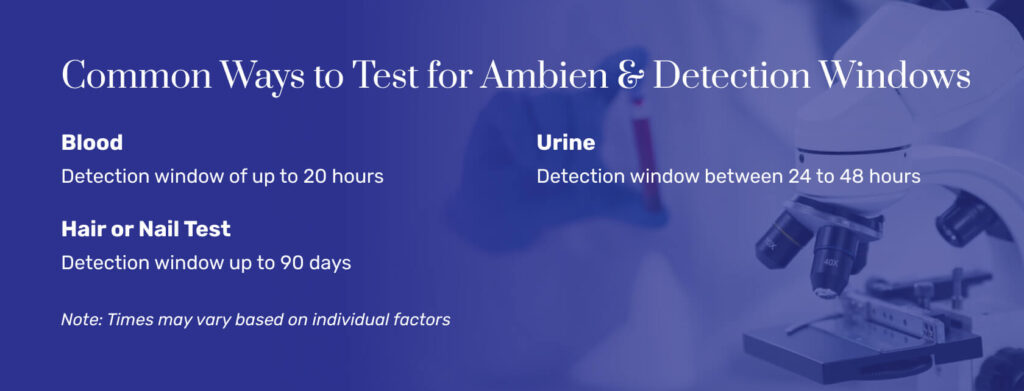Hair and nail drug tests can potentially detect the presence of the drug for much longer, up to 90 days, although this type of testing is not common and has its downsides.
Ambien Effects: How Long Do They Last?
Ambien, also known generically as zolpidem, is a prescription medication used to treat insomnia. It is a sedative-hypnotic, which means it slows down activity in the brain and helps to make a user drowsy.[1]
Ambien can also cause problems with memory, alertness, and coordination. It works fastest if taken on an empty stomach.[1]
Ambien’s effects will typically last between seven and eight hours.[1] A person who takes Ambien should be prepared to sleep for the night. It can be dangerous to take the drug if you will need to be up for several more hours, especially if you intend to drive.
This drug should only be taken as prescribed. Taking it outside of a prescription can be harmful.


Signs of Ambien Abuse
Ambien Detection Timeline
It’s possible to test for zolpidem use, although this is often only done in cases where the drug is suspected to have been used for self-harm, to facilitate sexual assault, or while performing an activity where taking the drug would be considered dangerous, such as driving.
The most common method used to test for zolpidem use is urine testing, although hair testing can be used to detect zolpidem use over longer periods. If you want to know how long does zolpidem stay in your system? This is the maximum amount of time that Ambien can generally be tested on different types of drug tests:[1-4]
| Time Since Use | Effect |
|---|---|
| Initial dose | Zolpidem acts quickly. A user is likely to experience drowsiness almost immediately after use. Memory, alertness, and coordination will all be affected. |
| 7–8 hours | This is typically the maximum amount of time a dose of zolpidem should affect a user. It remains in the system for longer than effects are felt. |
| 20 hours | This is typically the maximum window of detection if testing for zolpidem using blood testing. |
| 48 hours | This is typically the maximum window of detection if testing for zolpidem using urine testing. |
| 90 days | This is typically the maximum window of detection if testing for zolpidem using hair testing. |

Testing for Ambien
There are three main ways typically used to test for the presence of Ambien, with urine testing being the most common:[2-5]
Urine Drug Test
Urine testing is the most commonly used way to test for Ambien use. This type of testing is generally considered less invasive than blood or hair testing.
Urine testing for the drug has a detection window of between 24 and 48 hours if used at a therapeutic dose. The detection window can potentially even be longer if the drug is misused. This is a longer window than that offered by blood drug tests.
Blood Drug Test
While exactly how common blood testing for Ambien use might be hasn’t been reported, it’s clear that this type of testing is less common than urine testing. Blood testing is more invasive than urine testing and requires more expertise to do it safely.
Combined with the fact that blood testing is typically considered to have a detection window of about 20 hours when used to test for Ambien, which is a shorter window than with urine testing, there aren’t many benefits to this type of testing. The only real advantage is that it is harder for a person being tested to intentionally manipulate the results of a blood test.
Hair or Nail Drug Tests
Hair and nail testing has the advantage of a long detection window, with Ambien use potentially being detected up to 90 days after last use in ideal conditions. However, hair testing also has disadvantages that make its use infrequent.
Hair or nail testing is considered fairly invasive. It requires a sample to be removed from the person being tested. This type of testing also isn’t ideal for detecting short-term use of a drug.
Hair testing works better when testing for chronic, repeated use. The detection window is also highly variable, depending on the way a person maintains their hair and nails.
What Factors Impact How Long Ambien Stays in Your System?
Several things can potentially impact how long Zolpidem stays in a person’s system, including these:[6]
Dose taken, with excessive use potentially extending how long the drug is in a person’s system
Frequency of use, with more frequent use increasing the likelihood trace amounts of the drug, so it will be detectable for longer
An individual’s metabolism, which can be affected by health conditions, especially those impacting the kidneys and heart
FAQ About How Ambien Works in the Body
The following are some frequently asked questions regarding Ambien use:
Will Ambien show up in a drug test? Drug tests don’t typically test for the presence of zolpidem (the generic form of Ambien) unless there is a reason for such testing. However, it is possible to test for the drug. If the testing party, such as an employer, wants to look for Ambien, they will request a specific test that does so.
Ambien should typically take effect within minutes of taking a dose and should only be used exactly as prescribed. A person taking Ambien should be prepared to lay down and sleep for at least seven to eight hours.
While detection windows will vary depending on a person’s specific circumstances, Ambien use can typically be detected with a urine test for between 24 to 48 hours after a person’s last use.
- Zolpidem National Library of Medicine. Published November 15, 2019. Accessed September 18, 2023.
- Determining zolpidem compliance: Urinary metabolite detection and prevalence in chronic pain patients Schwope DM, DePriest A, Black DL, Caplan YH, Cone EJ, Heltsley R., Journal of Analytical Toxicology. 2014;38(8):513-518
- The clinical and forensic toxicology of Z-drugs Gunja N., Journal of Medical Toxicology. 2013;9(2):155-162.
- Zolpidem hair or nail drug test Arcpoint Labs of Tampa. Accessed September 18, 2023.
- A case of suicide attempt with zolpidem - will zolpidem show up on standard urine toxicology screening? Willner N, Schiff E., EXCLI journal. 2014;13:454-456. Accessed September 18, 2023.
- Drug elimination Garza AZ, Park SB, Kocz R., PubMed. Published December 4, 2020. Accessed September 18, 2023











